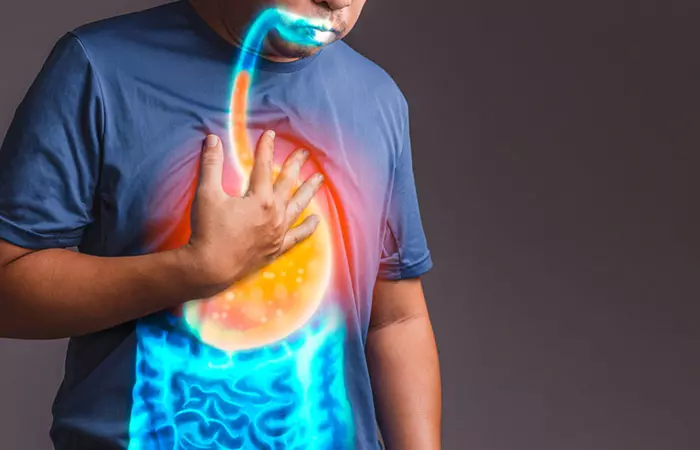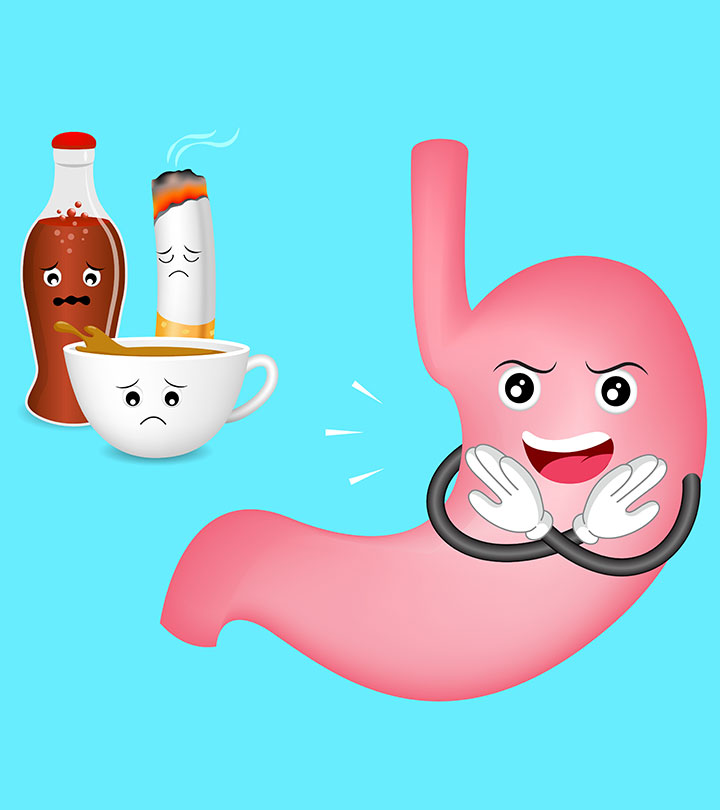If heartburn is haunting you every day, you are probably consuming a lot of acidic foods. These foods increase the acid levels in your stomach and put a strain on your gut. So, what is the way out?
Well, you simply need to cut down on certain foods and go for healthier options. Wondering what they are?
In this article, we understand what actually happens when you consume acidic foods, provide you with a list of foods that you should avoid, and suggest some substitutes. Keep reading to learn more!
In This Article
What Are Acidic Foods?
Foods that have a pH level of 4.5 or lesser and tend to cause more acidity in your stomach are acidic foods.
To make it simple, let’s understand the concept of acids and bases. All foods – solids and liquids – have a pH value that makes them acidic or basic.
Chemically speaking, the pH value of a compound tells you how many hydrogen molecules it has. On a scale of 1 to 14, all the compounds having a pH less than 7 are acidic. Water is neutral and has a pH of 7. All those compounds above 7 are alkaline or basic foods.
To summarize, lower the pH, higher the acidity. And what foods fall into the low pH, highly acidic category? Here you go…
Top Acidic Foods You Should Stay Away From
Contrary to popular belief, many vegetables and fruits trigger higher acid production and give you acidity.
Let’s look at the list of foods with their pH values that you should not be consuming if you have GERD(gastroesophageal reflux disease) because they decrease the pH of your gut.
| Fruits & Veggies | Meat | Dairy Products |
|---|---|---|
| Lime (2.0) | Sausages (3.3) | Buttermilk (4.4) |
| Cranberry juice (2.5) | Shellfish (3.3) | Cheese (4.5) |
| Orange (3.7) | Pork (3.8) | Sour cream (4.5) |
| Apple (3.75) | Fish (4.0) | Cottage cheese (4.7) |
| Pineapple (3.9) | Lobster (4.3) | Whey (5.0) |
| Strawberries (3.9) | Lamb (4.5) | Ice cream (4.8-5.5) |
| Tomatoes (3.4-4.7) | Beef (5.0) | Drinks |
| Green olives (4.2) | Bacon (5.5) | Carbonated soft drinks (2.2) |
| Peach (4.2) | Nuts | Coffee (4.0) |
| Mango (4.6) | Peanuts (3.8) | Pasteurized juices (4.0) |
| Dates (5.4) | Cashews (4.0) | Energy drinks (4.1) |
| Sauces | Pistachios (4.4) | Vegetable juice (4.2) |
| Vinegar (3.0) | Pecans (4.5) | Alcohol (4.3) |
| Pickles (3.2) | Sweeteners | Oils (3.0-5.0) |
| Mayonnaise (3.8-4.2) | Honey (4.0) | Cooked oil |
| Mustard (4.0) | Sugar (5.0) | Solid oil (margarine) |
| Soy sauce (5.0) | Artificial sweeteners (3.0) | |
| Corn syrup (3.8) |
So what if these foods are acidic? Why should you stay away from them? These are some questions you might be asking. I’m coming to that. Read on!
What Happens When You Eat Acidic Foods?
Everything that you eat has to come in contact with the gastric juice in your stomach. This gastric juice is highly acidic and has a pH between 1.5 to 3.5 (equivalent to hydrochloric acid).
Our body has mechanisms to strictly control the pH in the gut and levels of gastric juice in the stomach. When the pH of your stomach is already acidic, and you eat acidic foods, a cumulative effect is created that lowers the pH in your gut even more.
It’s like adding fuel to the fire!
There’s too much acid generated at once, which can give rise to conditions like:
1. Gastroesophageal Reflux Disease (GERD)

Image: Shutterstock
Consuming highly acidic foods can damage the protective inner lining of your stomach, giving you dreadful ulcers and terrible acid reflux.
What’s worse is if this acid reflux and inflammation continue and reach the upper GI tract and esophagus, which do not have a protective mucus-secreting cell lining (like your stomach). It can lead to chronic burning sensation, dyspepsiai XUpper abdominal irritation also referred to as indigestion, characterized by bloating, heartburn, nausea, or acid reflux. , acidity, heartburn, and ulcers in your mouth.
This is what happens when you have GERD. Trust me, you will not be able to swallow something as soothing as cold milk!
Did You Know? About 20% of the people in the United States have GERD (6). Related: 14 Home Remedies To Ease Burning Stomach: Causes And Prevention
2. Causes Tooth Decay
Eating or drinking sugary and starchy foods can lead to the formation of a thin, sticky, invisible film of bacteria called plaque all over your teeth.
When high sugar foods come in contact with plaque, the acids that digest the food attack your teeth till almost 20 minutes after you finish eating.
Repeated acid attacks like these break down the hard enamel layer on your teeth, ultimately leading to tooth decay. Something similar happens in the case of acid reflux too (1).
Related: How To Get Rid Of Cavities – 7 Home Remedies To Follow
3. Can Give Rise To Bone Diseases
Due to the Western diets that have a high acid, sodium, and bicarbonate content, and low potassium and calcium content, there is a gradual loss of bone density.
The urinary loss of calcium (which increases by 74% when on highly acidic foods), an inadequacy of potassium and vitamin D, and hypertensioni XHigh blood pressure — a serious medical condition that significantly increases the risks of mainly heart, brain, and kidney diseases. together trigger bone resorption and early onset of bone diseases like osteoporosisi XA bone disorder that arises when bone composition or structure alters or bone mass and bone mineral density decline. (2).
4. Could Cause Kidney Stones

Image: Shutterstock
The excretion of minerals like calcium, potassium, and magnesium through urine is essential for your kidneys’ health.
Having highly acidic foods can cause your kidneys to retain a fraction of these minerals while generating urine.
Over time, such mineral deposits turn into renal calculi or kidney stones. These could be fatal if left untreated.
Did You Know? According to the National Health Survey released in 2018, around 6 million adults in the United States have kidney disease (7).
So, how do we stop all this?
A simple way out is to reduce the consumption of such high acid-generating foods. But almost half of the foods we take in daily fall under this category. Some of them are highly nutritious too!
Then, how do we make it up?
The good news is that we have many substitutes for these foods that are equally nutritious but less acidic. You can try to choose the more alkaline options to prevent acid reflux.
Scroll down to find out what the options are.
Related: 16 Home Remedies For Kidney Stone Pain And Prevention Tips
Substitutes For Acidic Foods
Choosing less acidic or alkaline foods over highly acidic ones can prevent you from burning your gut and esophagus.
Take a look at this pH spectrum to understand what foods fall into acidic and alkaline categories.

Image: Shutterstock
For your quick reference, here are some easily available alkaline foods with their pH values that you can add to your grocery list:
1. Almonds and almond milk (6.0)
2. Artichokes (5.9-6.0)
3. Asparagus (6.0-6.7)
4. Avocado (6.2-6.5)
5. Basil (5.5-6.5)
6. Broccoli (6.3-6.8)
7. Cabbage (5.2-6.8)
8. Celery (5.7-6.0)
9. Garlic (5.8)
10. Ginger (5.6-6.0)
11. Kale (6.3-6.8)
12. Kelp (6.3)
13. Lima beans (6.5)
14. Mint (7.0-8.0)
15. Okra (5.5-6.6)
16. Spinach (5.5-6.8)
17. Swiss chard (6.1-6.7)
18. Tofu (7.2)
19. Tea (7.2)
20. Zucchini (5.9-6.1)
Do you want to know what wonders you can do with these? Scroll down for a surprise!
Avocado And Quinoa Salad (Quick And Comfy!)
Image: IStock
What You Need
- Ripe avocados: 4 (peeled and quartered)
- Quinoa: 1 cup
- Chickpeas: 400g, drained
- Parsley (flat leaf): 30g, torn
Let’s Make It!
- Cook the quinoa by putting one cup of quinoa in a pot with two cups of water. Bring it to a boil.
- Reduce the heat to a simmer, cover and cook for 12 minutes until the water has evaporated.
- Fluff with a fork until the grains are swollen and glassy.
- Toss all the ingredients together and season with sea salt and black pepper. (You can also add broccoli or kale for some crunch.)
- Serve warm with lemon wedges and olive oil.
- I know, you’re glad that you came to this page! You’re welcome!
In Conclusion…

Image: Shutterstock
Switching to a diet rich in foods with a higher pH, like the vegetables and greens listed in this article, will help you protect your body from undesirable chemical stress.
Formulate a diet that has 80% alkaline and 20% acidic foods so that you get the best of both worlds.
Acidic foods exhibit many negative effects on the body. These foods may cause GERD, tooth decay, bone diseases, and kidney stones. Replacing them with alkaline foods minimizes the risk of these conditions. Foods like almonds, asparagus, avocado, okra, spinach, swiss chard, tofu, and mint are alkaline. It is advisable to formulate a diet with 80% alkaline foods and 20% acidic foods for balanced nutrition. Completely avoiding acidic foods is also not recommended. Try out the easy and quick recipes mentioned above to enjoy alkaline foods in a helathy fashion.
Frequently Asked Questions
Are eggs acidic?
No. Eggs have neutral to slightly alkaline pH (pH of 7.6 to 8.5) (3).
Are bananas acidic?
Yes. Bananas have a slightly acidic to neutral pH (pH of 5.3 to 6.1) (4).
Are potatoes acidic?
Yes. Potatoes have a slightly acidic pH (pH 6.1) (5).
Which fruit is non-acidic?
Avocados and cantaloupe melons are alkaline in nature.
Sources
Articles on StyleCraze are backed by verified information from peer-reviewed and academic research papers, reputed organizations, research institutions, and medical associations to ensure accuracy and relevance. Check out our editorial policy for further details.
- The Best and Worst Foods for Your Teeth, University of Rochester Medical Health Center.
https://www.urmc.rochester.edu/encyclopedia/content.aspx?ContentTypeID=1&&ContentID=4062 - The Alkaline Diet: Is There Evidence That an Alkaline pH Diet Benefits Health? Journal of Environmental and Public Health, US National Library of Medicine, National Institutes of Health.
https://www.ncbi.nlm.nih.gov/pmc/articles/PMC3195546/ - Influence of carbon dioxide on the activity of chicken egg white lysozyme
https://www.sciencedirect.com/science/article/pii/S0032579119404999?via%3Dihub - Morphological, physicochemical, and antioxidant profile of noncommercial banana cultivars
https://www.ncbi.nlm.nih.gov/pmc/articles/PMC4431790/ - Tissue Damage, Temperature, and pH Induced by Different Electrode Arrays on Potato Pieces (Solanum tuberosum L.)
https://www.ncbi.nlm.nih.gov/pmc/articles/PMC5917672/ - Definition & Facts for GER & GERD
https://www.niddk.nih.gov/health-information/digestive-diseases/acid-reflux-ger-gerd-adults/definition-facts - Kidney Disease
https://www.cdc.gov/nchs/fastats/kidney-disease.htm
Was this article helpful?
“>
Related
The following two tabs change content below.
- Reviewer
- Author

Madhu Sharma, RD
Madhu Sharma is a member of the National Executive Committee of IDA. She has been associated for almost three decades with Pediatric Nutrition at PGI while serving in the Gastroenterology Department (20 years) and then the Advanced Pediatric Center (10 yrs) at PGIMER, Chandigarh. She is former Senior Dietitian from PGIMER, Chandigarh, retired in 2012. Madhu has been closely working…View Profile ›
Swathi Handoo, Health & Wellness Writer

Swathi holds a master’s degree in biotechnology from Osmania University and has worked in places where actual science and research happen. She has four years of experience and a Professional Certificate in Food, Nutrition & Research from Wageningen University. Blending her love for writing with science, Swathi writes articles on health and wellness and simplifies complex topics for readers from…View Profile ›
